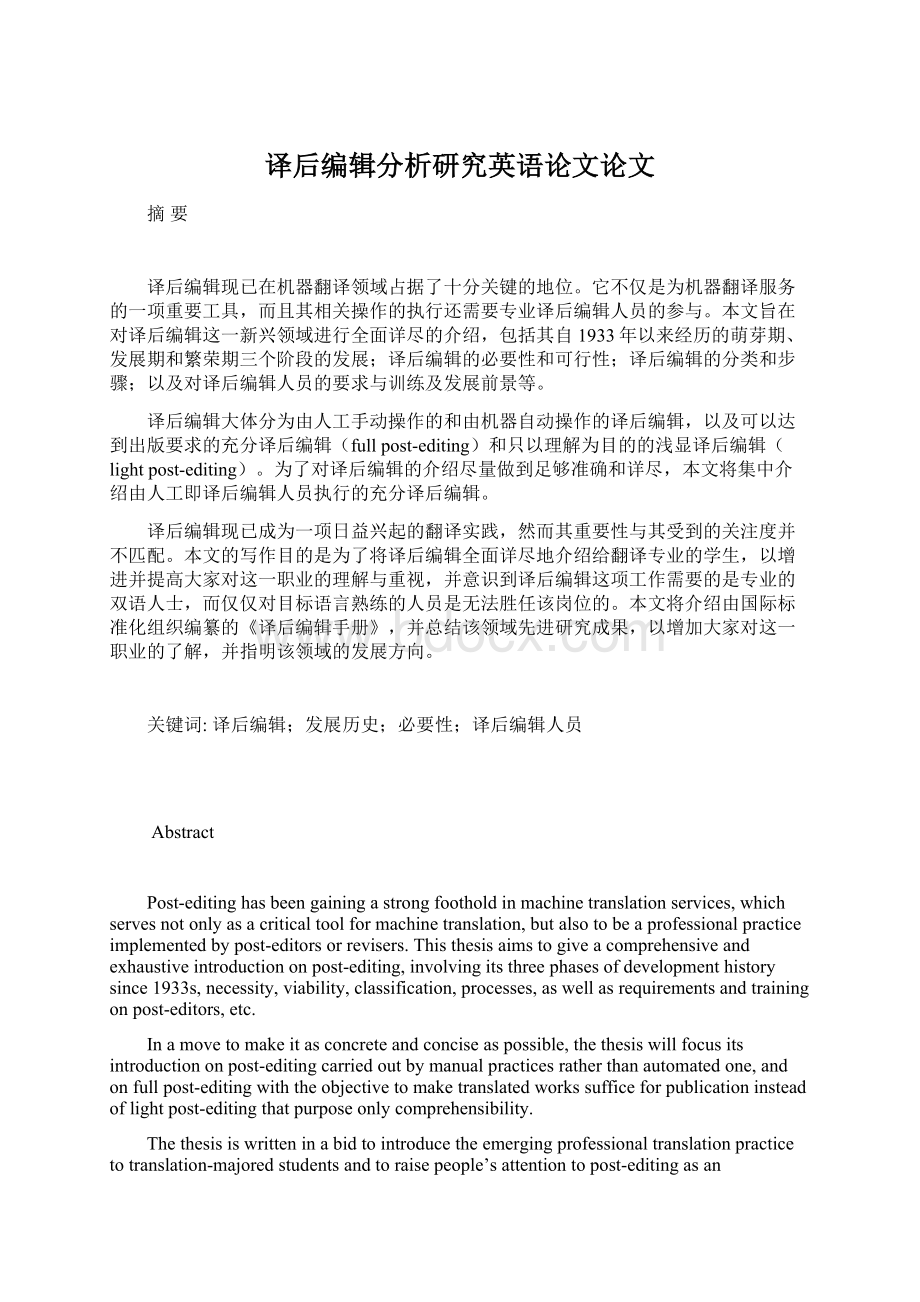译后编辑分析研究英语论文论文.docx
《译后编辑分析研究英语论文论文.docx》由会员分享,可在线阅读,更多相关《译后编辑分析研究英语论文论文.docx(13页珍藏版)》请在冰豆网上搜索。

译后编辑分析研究英语论文论文
摘要
译后编辑现已在机器翻译领域占据了十分关键的地位。
它不仅是为机器翻译服务的一项重要工具,而且其相关操作的执行还需要专业译后编辑人员的参与。
本文旨在对译后编辑这一新兴领域进行全面详尽的介绍,包括其自1933年以来经历的萌芽期、发展期和繁荣期三个阶段的发展;译后编辑的必要性和可行性;译后编辑的分类和步骤;以及对译后编辑人员的要求与训练及发展前景等。
译后编辑大体分为由人工手动操作的和由机器自动操作的译后编辑,以及可以达到出版要求的充分译后编辑(fullpost-editing)和只以理解为目的的浅显译后编辑(lightpost-editing)。
为了对译后编辑的介绍尽量做到足够准确和详尽,本文将集中介绍由人工即译后编辑人员执行的充分译后编辑。
译后编辑现已成为一项日益兴起的翻译实践,然而其重要性与其受到的关注度并不匹配。
本文的写作目的是为了将译后编辑全面详尽地介绍给翻译专业的学生,以增进并提高大家对这一职业的理解与重视,并意识到译后编辑这项工作需要的是专业的双语人士,而仅仅对目标语言熟练的人员是无法胜任该岗位的。
本文将介绍由国际标准化组织编纂的《译后编辑手册》,并总结该领域先进研究成果,以增加大家对这一职业的了解,并指明该领域的发展方向。
关键词:
译后编辑;发展历史;必要性;译后编辑人员
Abstract
Post-editinghasbeengainingastrongfootholdinmachinetranslationservices,whichservesnotonlyasacriticaltoolformachinetranslation,butalsotobeaprofessionalpracticeimplementedbypost-editorsorrevisers.Thisthesisaimstogiveacomprehensiveandexhaustiveintroductiononpost-editing,involvingitsthreephasesofdevelopmenthistorysince1933s,necessity,viability,classification,processes,aswellasrequirementsandtrainingonpost-editors,etc.
Inamovetomakeitasconcreteandconciseaspossible,thethesiswillfocusitsintroductiononpost-editingcarriedoutbymanualpracticesratherthanautomatedone,andonfullpost-editingwiththeobjectivetomaketranslatedworkssufficeforpublicationinsteadoflightpost-editingthatpurposeonlycomprehensibility.
Thethesisiswritteninabidtointroducetheemergingprofessionaltranslationpracticetotranslation-majoredstudentsandtoraisepeople’sattentiontopost-editingasanindispensableprocessthatneedstobeperformedbybilingualprofessionalsotherthananyonewhoisonlyproficientinthetargetlanguages.ByintroducingthePost-editingGuidelinesregulatedbyInternationalStandardizationOrganization(ISO)andconcludingtheresultsofresearchonpost-editingstudiedbyformerresearchers,thearticleisprojectedtobeapreliminaryentrancetopost-editingthatwillhighlightpeople’semphasisonitandcarveoutapromisingandguaranteedfutureofit.
KeyWords:
post-editing;developmenthistory;necessity;post-editors
Contents
摘要……………………………………………………………………………….…i
Abstract.........................................................................................................................ii
Introduction...................................................................................................................6
ChapterOneTheDevelopmentHistoryofPost-editing..............…………..……….7
1.1DevelopmentHistoryofPost-editingfrom1930sto1970s..........................7
1.2DevelopmentHistoryofPost-editingfrom1980sto1990s..........................8
1.3DevelopmentHistoryofPost-editinginthe21stCentury.............................9
ChapterTwoTheNecessityandViabilityofPost-editing...........…………..…...…11
2.1TheNecessityofPost-editing…….......................................………………11
2.2TheViabilityofPost-editing........................................................................13
ChapterThreeTheClassificationandProcessesofPost-editing..............................16
3.1TheClassificationofPost-editing................................................................16
3.2TheProcessesofPost-editing.......................................................................18
ChapterFourTheCompetencesandTrainingonPost-editors.................................20
4.1TheCompetencesonPost-editors...............................................................20
4.2TheTrainingonPost-editors........................................................................21
4.3TheFutureofPost-editing............................................................................21
Conclusion……………………………………………………………………………23
WorksCited.................................................................................................................24
Introduction
Post-editingisanimportantandcomplementarytoolofmachinetranslationincludingthepracticeofidentifyingandcorrectingproblemsanderrorsofmachine-translatedversion.Withtherisingdevelopmentofmechanicaltechnologiesandsomeinevitableproblemsgeneratedbymachineintranslation,post-editingstartstogainmoreattentionaroundtheglobeduetoitsnecessityandviability.However,post-editingisstillgreatlyneglectedbytranslation-majoredstudentsanddeniedbymanyprofessionalsasanoccupation.Asaresult,thisreportaimstogiveacomprehensiveandgeneralintroductiononpost-editingbasedonmultiplestudiesandresearchathomeandabroadaswellastheguidelinesonpost-editorsissuedbytheInternationalStandardizationOrganization(ISO),asanefforttodeepenpeople’sunderstandinginpost-editinganddissipatesomecommonmisapprehensionaboutit.Thereportwillintroducepost-editinginfourparts.First,thedevelopmenthistoryofpost-editingwillbeintroducedinChapterOnetohelpreaderscraveoutabroadoutlineofhowpost-editingisdeveloped.Second,thenecessityandviabilityofpost-editingwillbeextrapolatedinChapterTwobasedontheanalysisofinaccuracyandincorrectnessofmachinetranslation.Third,theclassificationandprocessesofpost-editingwillbeintroducedinChapterThreetoenrichreaders’knowledgeonpost-editing.Forth,thecompetencesandtrainingonpost-editorswillbeexplainedandtheprospectofpost-editingandthefutureofpost-editorswillbeforeseeninChapterFour.Fromthisreport,itistemptingtoconcludethatpost-editingwillbecomemoreandmorepopularasanindispensabletoolofmachinetranslationwithstricterrequirementsonpost-editorsandontranslationindustryasawhole.
ChapterOneTheDevelopmentHistoryofPost-editing
AsisexplainedbyAllen,post-editing,inbasicterms,is“thetaskofthepost-editorstoedit,modifyand/orcorrectpre-translatedtextthathasbeenprocessedbyamachinetranslationsystemfromasourcelanguageintoatargetlanguage”(Allen297).Soisacriticaltoolappliedtoimprovethequalityofmachinetranslation,thusitsdevelopmenthistoryisinevitablyassociatedwiththatofmachinetranslation.In17thcentury,theconceptofmachinedictionarieshadbeenputforwardandmaterializedbyproductivecitizensasDescartesandLeibniz,whowentoutoftheirwaystosurmountlanguagebarriersbyintroducinganintermediatelanguage.In1903,thetermof“machinetranslation”wasfirstlyusedbyCouturatandLeautodescribemechanically-aidedtranslation.In1933,thenotionofmechanically-aidedtranslationwasputintopracticebyaninvestoroftheSovietUnion.Thiswaswhenmachinetranslationwasinitiallymadeintoreality.Thenceforward,post-editinghascommenceditsunnoticeabledevelopmentwithlittleattention,whosedevelopmenthistoryhasbeenconcludedintothreephases:
formingstage,revivingstageandprosperousstage.
1.1DevelopmentHistoryofPost-editingfrom1930sto1970s
Theperiodfrom1930sto1970switnessedpost-editing’sincipientphaseofdevelopmentsinceitsoriginalityin1933.Thisyear,aninvestorfromtheSovietUnionnamedTroyanovskyinventedamachine,whichwasabletotranslatealanguageintoanotherinmechanicalway.Hecreatedasetoflogic-analyzingsymbolsanddividedtheprocessesoftranslationintothreeparts.Inthefirstandthethirdparts,professionally-trainededitorswouldrelativelyencodethesourcelanguageinthesymbolsanddecodethesymbolsintothetargetlanguage,whileinthesecondpart,themachinewouldplayitspartbytransferringthemeaningofsymbolsfromthesourcelanguagetothetargetone.Inthemechanically-aidedtranslationprocesses,thoseprofessionally-trainededitorswerepracticallytheinitialrudimentofpost-editors.
In1946,theworld’sfirstcomputer,ENIAC,wasdesignedandproducedbyJ.P.EckertfromtheUnitedStates,whosestartlingcomputingratesgaverisetopeople’sconcernontherevolutionoftranslation.Fromthenon,thepracticeofmachinetranslationhadstartedtospringup,which,undoubtedly,couldnotbeachievedwithouttheaidofpost-editing.However,duetothebackwardmechanicaltechniquesandthepoorapplicationofpost-editing,thequalityofmachinetranslationstillletmanypeopledowndespiteitsdecadesofdevelopment.Therefore,in1966,AutomaticLanguageProcessAdvisoryCommittee(ALPAC)organizedbyAmericanScienceAcademypublishedareportnamed“LanguageandMachine”,inwhichtheviabilityofmachinetranslationwasfullydisavowedbysayingthattherewerefewreasonsforustogivegeneroussupporttomachinetranslationatthemoment(AutomaticLanguageProcessingAdvisoryCommittee16).
Thedevelopmentofmachinetranslation,andpost-editingcorrespondingly,remainedlifelessuntil1976whenapracticalmachinetranslationsystemTAUMMETEOwasinventedbyCanadatoprovideofficialweatherforecastservices.Thismarkedtherenaissanceofmachinetranslationandtheinitialstartingpointofpost-editing.Sincethen,ahandfuloftranslatorsstartedtobefreedfromlengthyandtiresometranslatingworksbyhandandturnedtocheckandimprovetheoutputofmachinetranslationsystem(MachineTranslation8).
1.2DevelopmentHistoryofPost-editingfrom1980sto1990s
Thestageof1980s-1990shadseenaphaseofrenaissanceofpost-editing,orbettertosayoflightpost-editing,whichwasactuallydrivenbydintoftherelativelypoortechnologicaldevelopment.Inthe80sand90s,withtherisingdemandforinternationalexchangesandtrade,lightpost-editingrosetobecomethemaintoolformachinetranslation.AccordingtoGarcia,“Lightpost-editingaimedtomakethemachine-generatedtextcomprehensible.Itwasnotmeantfordisseminationpurposes,butr